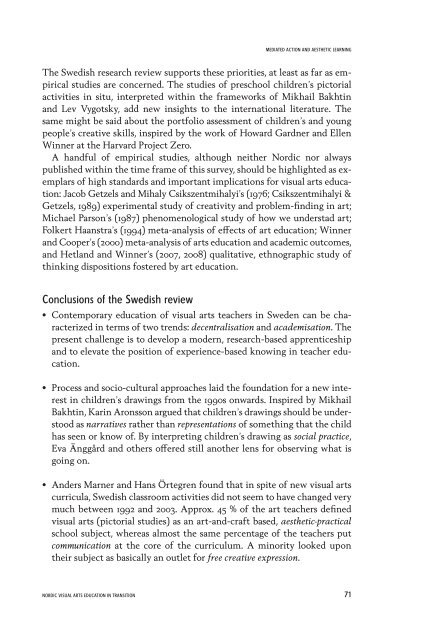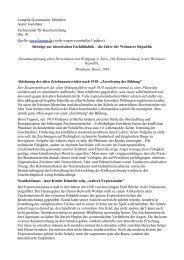Research in Visual Arts Education - The National Society for ...
Research in Visual Arts Education - The National Society for ...
Research in Visual Arts Education - The National Society for ...
Create successful ePaper yourself
Turn your PDF publications into a flip-book with our unique Google optimized e-Paper software.
MEDIATED ACTION AND AESTHETIC LEARNING<br />
<strong>The</strong> Swedish research review supports these priorities, at least as far as empirical<br />
studies are concerned. <strong>The</strong> studies of preschool children’s pictorial<br />
activities <strong>in</strong> situ, <strong>in</strong>terpreted with<strong>in</strong> the frameworks of Mikhail Bakht<strong>in</strong><br />
and Lev Vygotsky, add new <strong>in</strong>sights to the <strong>in</strong>ternational literature. <strong>The</strong><br />
same might be said about the portfolio assessment of children’s and young<br />
people’s creative skills, <strong>in</strong>spired by the work of Howard Gardner and Ellen<br />
W<strong>in</strong>ner at the Harvard Project Zero.<br />
A handful of empirical studies, although neither Nordic nor always<br />
published with<strong>in</strong> the time frame of this survey, should be highlighted as exemplars<br />
of high standards and important implications <strong>for</strong> visual arts education:<br />
Jacob Getzels and Mihaly Csikszentmihalyi’s (1976; Csikszentmihalyi &<br />
Getzels, 1989) experimental study of creativity and problem-f<strong>in</strong>d<strong>in</strong>g <strong>in</strong> art;<br />
Michael Parson’s (1987) phenomenological study of how we understad art;<br />
Folkert Haanstra’s (1994) meta-analysis of effects of art education; W<strong>in</strong>ner<br />
and Cooper’s (2000) meta-analysis of arts education and academic outcomes,<br />
and Hetland and W<strong>in</strong>ner’s (2007, 2008) qualitative, ethnographic study of<br />
th<strong>in</strong>k<strong>in</strong>g dispositions fostered by art education.<br />
Conclusions of the Swedish review<br />
• Contemporary education of visual arts teachers <strong>in</strong> Sweden can be characterized<br />
<strong>in</strong> terms of two trends: decentralisation and academisation. <strong>The</strong><br />
present challenge is to develop a modern, research-based apprenticeship<br />
and to elevate the position of experience-based know<strong>in</strong>g <strong>in</strong> teacher education.<br />
• Process and socio-cultural approaches laid the foundation <strong>for</strong> a new <strong>in</strong>terest<br />
<strong>in</strong> children’s draw<strong>in</strong>gs from the 1990s onwards. Inspired by Mikhail<br />
Bakht<strong>in</strong>, Kar<strong>in</strong> Aronsson argued that children’s draw<strong>in</strong>gs should be understood<br />
as narratives rather than representations of someth<strong>in</strong>g that the child<br />
has seen or know of. By <strong>in</strong>terpret<strong>in</strong>g children’s draw<strong>in</strong>g as social practice,<br />
Eva Änggård and others offered still another lens <strong>for</strong> observ<strong>in</strong>g what is<br />
go<strong>in</strong>g on.<br />
• Anders Marner and Hans Örtegren found that <strong>in</strong> spite of new visual arts<br />
curricula, Swedish classroom activities did not seem to have changed very<br />
much between 1992 and 2003. Approx. 45 % of the art teachers def<strong>in</strong>ed<br />
visual arts (pictorial studies) as an art-and-craft based, aesthetic-practical<br />
school subject, whereas almost the same percentage of the teachers put<br />
communication at the core of the curriculum. A m<strong>in</strong>ority looked upon<br />
their subject as basically an outlet <strong>for</strong> free creative expression.<br />
NORDIC VISUAL ARTS EDUCATION IN TRANSITION 71



